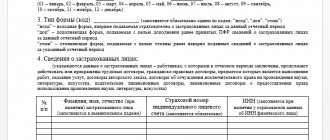Providing information on the average number of employees
A report on the average number of personnel is necessary to comply with legal requirements when filling out the following declaration forms:
- Calculation of accrued and paid insurance contributions for compulsory social insurance (Form 4-FSS);
- Calculation of accrued and paid insurance contributions for compulsory pension insurance (form RSV-1 PFR);
- Information on the average number of employees for the previous calendar year (KND form 1110018);
- Information on the number, wages and movement of workers (form P-4);
- Information on the main performance indicators of a small enterprise (Form N PM);
The average number of employees depends on:
- Possibility of obtaining tax benefits if an enterprise uses the work of disabled people (VAT, income tax, property tax and land tax);
- And the need to send declarations for the previous year to the tax service in the form of an electronic document if the number of employees of the enterprise is higher than one hundred people. (Article eighty of the Tax Code of the Russian Federation);
Information on the average number of employees must be prepared by the company regardless of whether the company has employees or whether the company is actively operating. If there are no personnel on the company’s staff, the number zero must be entered in the corresponding field of the reporting form. The average headcount is calculated both for a long-running enterprise, and for a newly created one (before the twentieth day of the month that follows the month the company was founded) and for a closing enterprise (information should be prepared not for the month, but for the specific date of liquidation of the company).
Who is included in the calculation of the average headcount?
To calculate the average number of employees in 2021, it is necessary to take into account the following categories of workers:
- Owners of the company who work and receive salaries in it;
- Employees on the company's staff who have employment contracts with the company;
- Part-time workers, if they are not employees of this company;
- Students who undergo industrial practice at the enterprise during the holidays (if GPC agreements have been drawn up with them);
- Military personnel, as well as those serving sentences in penal colonies, if they are involved in the work of the company under relevant agreements with government agencies;
Both the company’s employees who showed up for work and those employees who are absent from work due to any circumstances (for example, sent on a business trip, sick, on vacation, etc.) should take part in the calculation of the average headcount.
The following categories of workers are not included in the calculation of the average number of employees:
- Women during periods of maternity leave;
- Company employees who have taken parental leave;
- Employees of the enterprise who took additional study leave without pay;
- Employees of the company who are passing entrance exams to universities and have taken additional leave without pay;
- Performing work under copyright contracts;
- Individual entrepreneur, if the entrepreneur works under a GPC agreement;
- Full-time employees of the company who are at the same time external part-time workers, or who work in parallel under a GPC agreement with their organization (they are counted only once, as a full-time unit);
- Employees who wrote a letter of resignation and did not return to work after that;
- Employees who were transferred to work in another organization or sent to work abroad;
- Employees sent for off-the-job training;
- Persons with whom a student agreement has been concluded who receive a scholarship during their studies;
- Lawyers, military personnel and members of cooperatives (without an employment contract);
Employees with less than normal working hours (normal - forty hours per week) are taken into account in the average headcount in a special way. Their number should be taken into account in direct proportion to the time worked. For example, an employee who was assigned a 20-hour work week (“part-time”) should be counted in the payroll as 0.5 staff units.
It is important that this category does not include employees with reduced working hours. The Labor Code of the Russian Federation establishes reduced working hours for disabled people, workers under the age of eighteen, and also, in some cases, workers combining work with training.
In cases where personnel are transferred to part-time work at the initiative of the company (for example, production volume has decreased and everyone works 4 days a week for 8 hours instead of the usual 5), employees must be counted in the average headcount according to standard rules - as entire staff units.
Base for calculating the average headcount
The average number of employees of a company should be calculated on the basis of time sheets. The company must daily take into account the number of its employees in their time sheets. The payroll must include the following company employees:
- Employees reporting to work and performing their job duties;
- Having a day off on a given day of the month, according to the work schedule of the enterprise;
- Those who received a day off or a day of rest in accordance with the Labor Code of the Russian Federation (for overtime, work on weekends and holidays, etc.);
- Personnel who did not go to work on the counted day due to illness, who are on vacation of any kind or on a business trip;
- Personnel on study leave, but only when the employee retains his salary;
- Employees who are not present at work due to absenteeism;
- Those who are at work, but are not actually working due to downtime, or workers who are on strike;
Simply put, all employees of the company are included in the payroll, regardless of their attendance or absence from work on the date taken into account.
Summary statistics
Sometimes a HR specialist or accountant does not need a full-fledged report to work, but may need statistical information on the average number of employees of the enterprise. You can prepare it using the “Personnel (working in the period)” view in the “Organization” menu.
Be sure to indicate the period for which you want to receive a sample. Please note that in the working window there is one more date - the one for which the data is generated. This allows you to track the difference: if a person worked during the reporting period and is now fired, the program will show this.
The table contains the employee's last name, first name and patronymic, department and position, start and end dates of work, rate and work schedule, as well as two columns with the results of automatic calculation of the average and average number of employees for each employee. To see the overall SCH indicator, you can select “Show / Hide totals” (F9 key) in the context menu, and the total result will be displayed below.
Naturally, the data in the columns for the same employee will differ. In the summary of the payroll number there can be 1 or 0. We remind you: zero in the payroll number will appear for employees who are not included in the calculation of data on the average. The payroll average is calculated in proportion to the time worked, so in a table with data, one person may have a result of 0.67, while another may have a result of 0.13.
Formula for calculating the average number of employees per month
The calculation of the average number of employees differs for full-time workers and for the following categories of workers: part-time workers and external part-time workers, workers under civil-sector agreements.
The category of part-time workers does not include workers with reduced working hours (disabled people, workers under the age of eighteen, and other categories). These workers are counted in the average payroll according to the rules for full-time workers, that is, as entire staff units.
The average number of full-time employees per month is equal to the amount on the payroll for each day of the month divided by the number of calendar days of the month. It is important that the payroll must be determined for each day of the month, regardless of whether it is a working day or a non-working holiday. The resulting amount is also divided by the total number of calendar days of the month.
How to calculate the payroll number on a non-working or weekend day? The payroll number for the weekend is equal to the payroll number for the previous working day. If there are several days off in a row, the payroll number of each of them is equal to the last previous working day.
In order to calculate the average number of part-time workers , external part-time workers and workers under civil and personal agreements, it is necessary to recalculate to full-time employment. First of all, this requires determining the number of man-days they worked.
The number of man-days worked is equal to the sum of man-hours worked divided by the working day established for a specific employee. In other words, for workers with different working hours, the calculation must be carried out separately. The main options for part-time working hours:
- With a 36-hour five-day period – 7.2 hours;
- With a 36-hour six-day period - 6 hours;
- With a 24-hour five-day period - 4.7 hours;
- With a 24-hour six-day period - 4 hours;
Moreover, if an employee was sick on a working day, was on vacation or skipped work, these days are included in the calculation of man-hours worked based on the number of hours worked on the previous working day.
After calculating the total number of man-days worked, it is necessary to calculate the average number of employees in terms of full-time employment. To do this, the total number of person-days worked is divided by the number of working days in the month.
Formula for calculating the average number of part-time workers:
There is another, perhaps simpler, method for calculating the average number of part-time workers. To do this, you need to divide the duration of part-time work by normal (8 hours). For example, if an employee works 4.7 hours a day, but he is counted for each working day as 0.5875 staff units. Then the resulting value must be multiplied by the number of days worked by the employee per month. Next, the sum of the obtained values for all part-time workers is calculated, and this sum is divided by the number of working days according to the calendar.
In the final calculation of the average headcount for the enterprise as a whole, the total values for all categories of employees are summed up and rounded to a whole number according to the general rounding rules: if the number after the decimal point is 5 or more, then the number is rounded up.
How to count manually
If you want to check that the online calculator is working correctly, but don't know how to calculate the average number of employees for the year, start by calculating the monthly figures. To do this, the following formula is used: first, the number of all employees is summed up, and then the result is divided by the number of days in the month.
Let us show how the formula for the average number of employees works, using the example of September.
Please note: the number of employees on working days is determined by the working time sheet; on non-working days it is assumed to be equal to the number of employees on the last working day. For underemployed people, the average is determined using a different formula:
If you figure out how to calculate the average number of employees per month, finding annual figures is not difficult. If you need information from the beginning of the year to the reporting month, sum up the values for each of the past months, and divide the resulting amount by the number of these months. To obtain annual figures, the formula for calculating the average number of employees per year changes and looks like this:
Regardless of whether the company worked for the entire billing period or not, to calculate the average headcount for the year, you must always put 12 in the denominator.
Online calculator for calculating the average number of employees
The average headcount should be calculated automatically in personnel accounting and payroll systems (for example, in 1C). You can also calculate the average number of employees in 2021 using our online calculator. To calculate for a month, you must enter data on the payroll number for each date of the month in the appropriate cells of the table. Weekends are highlighted in orange (Attention, weekends correspond to the 2015 calendar! To calculate the average headcount for 2016, you need to edit the formulas in the cells in accordance with the schedule of weekends and working days).
Providing information on the average number of employees
Individual entrepreneurs provide data on the average number of employees at the place of registration. LLCs submit information at the location of their office. There are three ways to provide information - in person to the Federal Tax Service, by mail or electronically via telecommunication channels.
The deadline for submitting a certificate of average number of employees is until the twentieth of January. For newly established enterprises - until the twentieth day of the month following the date of establishment of the company.
The fine for failure to submit a certificate of average number of employees is 200 rubles.
Calculation by month
To determine the average headcount by month, the program provides a separate calculation form. In the Current Work / Reports menu, select the desired item, and double-clicking on the desktop will open the options window. The setup is carried out in a similar way to the “Staff and Average Headcount” report, but the printed form looks slightly different.






